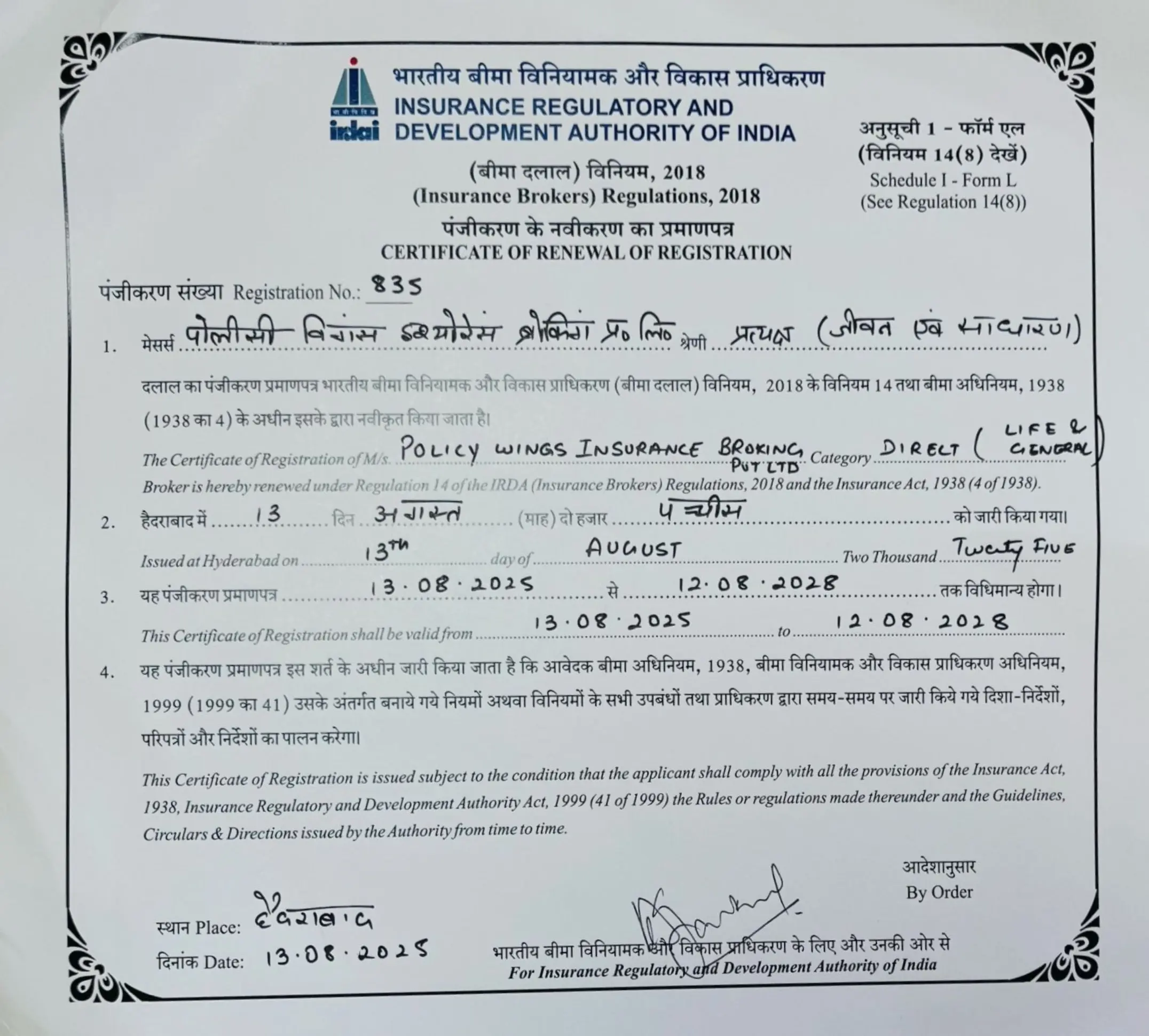Copay In Health Insurance
Today, it has become challenging for individuals in the middle-income group to access affordable medical treatment from reputable hospital facilities. Despite the country’s rapid economic growth many aspects of life including affordable healthcare options still need to be improved. This is why having a health insurance policy is not just a choice but a necessity for receiving adequate healthcare in our country. By having a healthcare policy, you can protect yourself from the financial burdens of sudden medical emergencies.
However, in some cases, insurers choose to share the risk of medical emergencies with the policyholder by co-sharing the claim amount. This could be taken as an additional option by the policyholder in order to reduce premiums as well. This option is called the co-payment clause and in this article, we will discuss this concept in detail.
What is Copay? It's meaning and definition:
A copay, also known as a co-payment in health insurance, is part of the approved claim amount that you are responsible for paying. Reviewing the copay clause to determine the specific amount you will need to contribute towards claim settlement and prevent any unexpected financial burdens is essential.
This percentage usually falls between 10% and 30% and is usually required for senior citizen health insurance policies. The insurer will only cover the remaining balance of the claim. In this system, the insurance company pays most of your claim, but you are responsible for a part of the cost. The specific percentage you need to pay, known as the copay, varies depending on the medical service you receive.
If you choose a lower copay amount, you will have to pay higher premiums for your health insurance. Copayment clauses are mainly applied to health insurance policies for senior citizens. This type of policy is more common in big cities where treatment costs are higher compared to smaller towns and cities.
What Is Copay In Health Insurance?
In health insurance, copay refers to the percentage of the claim amount that policyholders must pay while the insurance company covers the remaining part. Multiple insurance companies offer health insurance plans with needed copay clauses, while others offer voluntary copayment options. Selecting for voluntary copayments allows policy buyers to enjoy reduced premiums.
Copayment clauses in health insurance policies are more cost-effective because they decrease the insurer’s liability by sharing losses between the policyholder and the insurer. For example, if a health insurance policy has a 10% copayment clause and a claim worth Rs. 40,000 arises, the policyholder must pay Rs. 4,000 (10% of the claim amount) themselves, while the insurance company would cover the remaining Rs. 36,000.
Types Of Copay Clauses In Health Insurance:
Multiple copay clauses in health insurance relate to various factors. Let us examine some common types of copay clauses in health insurance:

The age factor plays a significant role in influencing medical conditions and complications. As individuals grow older, their healthcare needs increase, resulting in higher treatment expenses.
Hence, some insurance providers often implement copay details for senior citizens to manage these risks. Many health insurance plans offer age limitations that provide challenges for older individuals seeking coverage.
For example, most senior citizen health insurance plans usually have a compulsory co-payment clause incorporated.

Some group health insurance plans also have a copay clause within the corporate policy. It means that you must pay a copay if you receive treatment at a hospital not affiliated with your insurance provider. In some cases, co-pay is applied only in reimbursement claims and not in cashless, but it totally depends on the terms and conditions settled between the insurer and the insured while renewing their group mediclaim policies.

If there are any existing medical conditions or serious illnesses, the insurance provider might include a copay clause due to the high cost of treating such health issues. In this case, you might have to pay a part of the expense for any claim related to your pre-existing disease.

Medical costs are higher in urban cities than in smaller towns, but treatments are usually considered to be better. So, if you have a health insurance plan in a Zone B city and get your treatment in a Zone A hospital, you might have to pay a zonal co-payment for the same.
Thus, insurers may choose the copay clause for individuals in bigger cities to reduce the potential risk of increased medical expenses.
How Does The Copay Work In Health Insurance?
An insured person can make a claim for health insurance in two ways: cashless treatment or reimbursement of expenses. In the case of cashless treatment, the health insurance company directly settles the costs included with the hospital where the insured or their family members are receiving treatment.
On the other hand, if the insured chooses reimbursement, the health insurance company will repay them for the expenses they have paid while receiving treatment. Two scenarios can result from selecting a copay method. If you decide on a higher copay, your total premium payment will decrease, but you must pay more during a claim.
On the other hand, if you opt for a lower copay, the amount you must pay during a claim will be less, but your insurance policy premium will be higher. For example, if you have chosen a 10% copay, your insurance provider will cover 90% of the claim amount, and the remaining portion will be your responsibility to pay.
Example Of Copay In Health Insurance:
The ideal example of a copay in health insurance is when someone obtains insurance with a claimable amount of Rs. 5 lakhs, and their policy includes a copay condition of 10%. In this scenario, the insurance provider will cover Rs. 4.5 lakhs after deducting non-payable expenses, leaving the individual responsible for paying the remaining amount. Some health insurance plans require a copay clause, while others allow policyholders to choose whether to include it.
Example of Zonal Copay:
An example of zonal copay in health insurance is when individuals living in different zones, such as Mumbai (Zone A), Jaipur (Zone B), or Jabalpur (Zone C), are required to pay varying premiums for the same insurance coverage. For instance, if you reside in Mumbai, you may need to pay a bonus of up to Rs. 6,448 for a Rs. 10 Lakh insurance policy. Whereas, if you were living in Jaipur, your premium could be around Rs. 5,882. Furthermore, residents of Jabalpur or any other Zone C city would have an even lower premium cost, with only Rs. 5,315.
Benefits and Features of Copay In Health Insurance:
In health insurance, a copay clause offers to share a claim amount the policyholder must pay. To better understand copay in health insurance, it is important to be aware of its benefits and features.
1. Financial Support:
Having health insurance ensures that you have financial support in case of unexpected medical costs. It helps you to pay for hospital stays, medical treatments, surgeries, medications, and other healthcare expenses. By having health insurance with a copay clause, you can avoid the stress of dealing with high medical bills that can negatively impact your finances.
2. Cashless Hospital Stay:
An extensive range of health insurance plans offer the advantage of cashless hospitalisation, providing convenience for policyholders. The copay feature allows individuals to be admitted to a hospital within the designated network without making an initial payment for their medical costs.
Instead, the insurance company manages the settlement of bills directly with the hospital, following the guidelines and limits outlined in the policy. This facility reduces the need to arrange urgent funds during emergencies. Thus it offers financial relief to those insured with a copay clause.
3. Post And Pre-Hospitalisation Cover:
Health insurance plans that include a copay clause cover not just hospitalization fees but also the costs before and after a hospital stay. It includes expenses for follow-up treatments, medications, medical tests and necessary doctor appointments.
4. Daycare Benefits:
Certain health insurance plans cover specific daycare procedures, which do not necessitate a hospital stay lasting more than 24 hours. These procedures include cataract surgery, dialysis, chemotherapy and similar treatments. Including daycare procedure coverage guarantees financial aid for essential medical treatments, eliminating the need for hospital admission.
5. Maternity Support:
The copay clause provides maternity benefits covering the costs of pregnancy and giving birth. These benefits commonly include consultations before and after the birth, hospitalization expenses, delivery fees, and sometimes even care for the newborn. Maternity coverage is crucial for individuals looking to have a baby or grow their family.
6. NCB (No Claim Bonus):
The copay clause in health insurance policies includes a no-claim bonus condition. It means that if an individual does not submit any claims within a policy year, their eligible coverage can increase when the policy is renewed. The no-claim bonus encourages policyholders to prioritize their health, making fewer claims while gradually providing them with higher coverage.
7. Extensive Wellness Advantages:
Some insurance providers include wellness programs and benefits in their copay plans. These programs offer reduced fees for access to telemedicine services, gym memberships, preventive screenings, and regular health check-ups. These wellness benefits primarily aim to provide a healthy lifestyle and boost proactive healthcare practices.
8. Portable Services:
Health insurance plans that include a copay clause also provide the convenience of portability. It enables individuals to transfer to a new insurance provider without losing the acquired benefits. This clause enables policyholders to easily explore alternative options for coverage, service, and premiums.
Is Copay Compulsory?
Most insurance companies include the copay clause in health insurance policies targeting individuals above a particular age. Typically, health plans designed for senior citizens require mandatory copay clauses. Occasionally, insurance companies include copay clauses only if policyholders select treatment at a hospital outside the network.
Some co-pays are compulsory, wherein the policy issuance or acceptance depends on whether you as a policyholder accept the copayment clause or not. While in some plans, you can opt for a voluntary co-pay option when you wish to reduce the premium.
Voluntary Deductible Vs. Copay - Not The Same:
Both voluntary deductible and copay are distinct terms with different meanings. When you file a claim, you must pay the deductibles according to the clause; the insurance company will cover the remaining amount.
If your insurance policy includes a copay provision, the cost will be divided between you and your insurer based on the agreed percentage. The copay percentage is specified in the policy document.
Let’s understand this with an example. Say you have a health insurance plan of Rs. 10 lakhs with a deductible of Rs 2 lakhs. So, in the first claim of Rs 1.5 lakhs, your health insurance plan would not pay any amount since the total claim amount is less than the deductible limit. However, if the subsequent claim of say Rs 1 lakh, then the amount is more than Rs 2 lakhs, i.e. Rs 50,000 would be paid by the health insurance plan because the total amount for both the claims together crosses the deductible threshold of Rs 2 lakhs. So, in a deductible, a claim gets triggered only after the claim amount crosses the threshold limit of the deductible.
However, if the same Rs 10 lakhs health insurance plan had a 10% co-payment clause, then irrespective of the total claim amount, say Rs 1.5 lakhs, 10% of that, i.e. Rs. 15,000 would have to be paid by you on an out-of-pocket basis. the remaining 90% of the amount, i.e. Rs. 1,35,000 would be paid by the insurer.
Why Do Insurers Include a Copay Clause In The Policy?
The insurer includes a copay clause to cut costs while settling claims. In addition, there are various other reasons why insurance providers incorporate copayments into their health insurance plans.
1. Prevent Policy Misuse:
Policyholders may make claims for treating diseases that don’t necessitate high treatment costs. The copay facility aims to prevent the misuse of insurance policies. Policyholders must allow a part of the bill when filing a claim. It also ensures that health insurance policies are used wisely.
2. Consider The Need For Costly Treatments:
Individuals with health insurance must select top-notch medical facilities or expensive hospitals even when it is not required. As a result, the amount to be claimed from insurance becomes high. It burdens the insurers with unnecessary costs. When the policyholders select the hospitals which can increase the expenses, insurance companies implement a copay clause.
Things You Should Consider Before Opting for Health Insurance with Copay Clause:
While you may find health insurance plans that include copayments more affordable, you must evaluate your coverage requirements before choosing this option. You should also ensure that you have enough finances to cover your portion of the hospital bills before selecting a plan that includes copay options. Here are some of the essential points:
1. Saving Aspects:
It is necessary to ensure sufficient savings to cover potential hospitalisation costs if you consider purchasing a copay health insurance policy.
2. Coverage Needs:
Plans that have high copays are relatively less expensive. It also implies that you must pay a specific portion when filing a claim. Thus, evaluating your coverage needs before purchasing a cheaper plan is essential.
3. Condition Of Health:
While you may think you’re healthy and have no challenging health conditions, selecting a health insurance policy with a high copay is a method to save on premiums. You could pay more for treatment costs when dealing with complex and unexpected medical expenses. So, evaluating this factor before opting for a policy that includes a high copay clause is essential.
4. Other Factors:
When purchasing a health insurance plan in India with a copay clause, it is important to consider various factors besides copay, such as the procedure for settling claims, the ratio of successful claim settlements, additional services offered, what is covered and what is not covered in the plan.
Situations In Which You Should Opt For A Policy With A Copay?
A health insurance plan with a copay clause might be appropriate for individuals fulfilling the following requirements.
A. From the policyholder’s point of view:
a. To reduce premium:
If you are in search of a health insurance option that is more budget-friendly, choosing a plan that offers a copayment feature can assist in reducing your premium payments. It is beneficial if your objective is to save money on your monthly insurance bills.
b. Increases the chances of underwriting the policy, esp for senior citizens or individuals with Pre-existing diseases:
If you are in good health and don’t expect to go to the doctor often or undergo extensive treatments, a plan that includes copayments could be a suitable choice. Such programs don’t require detailed underwriting of policies specifically for senior citizens. Since you won’t need much medical care, the copayment amount you must pay stays the same or goes out of pocket.
B. From the Insurer’s point of view:
a. Reduces chances of unnecessary claims:
Insurance providers include a copay clause in their policies to reduce the chances of policyholders making excessive claims. For instance, individuals may try to file claims for treatments that do not require expensive medical care. By including a copay clause, insurance companies can prevent the misuse of insurance policies in such cases.
b. Avoids admission to unnecessarily expensive hospitals:
With the increasing treatment cost, many individuals still seek medical care at expensive hospitals, leading to unnecessary expenses. For example, if there is a copay requirement of 10% for treatment costs, a bill of Rs. 50,000 would mean paying Rs. 5,000. However, if treatment is sought at a costly medical centre, the bill could rise to Rs. 100,000 for the same treatment, resulting in a copay of Rs. 10,000. Thus, it is essential to include a copay option, as it would motivate the average policyholder to avoid getting treatment at hospitals with high expenses.
Disadvantages Of Copay:
With multiple advantages, copay has certain disadvantages which are necessary to consider while selecting a health insurance policy with a copay clause:
1. Increases OOP Expenses:
If the copay amount is high, it may delay the policyholder from getting medical treatment for challenging medical conditions. Thus, the purpose of purchasing health insurance is defeated if an individual is required to pay a significant amount personally as a copayment.
The main objective of buying health insurance is to reduce out-of-pocket expenses. Suppose the insured individual cannot obtain the necessary financial help from the health insurance provider when needed. In that case, the goal of purchasing a health plan with a copay still needs to be fulfilled.
2. Works Well When The Hospitalisation Is Infrequent Or A Lower Amount:
Selecting a policy that requires a higher copay results in a lower premium, which is advantageous for individuals who don’t frequently need hospitalisation and can help reduce costs. However, this benefit only applies until a claim is made under the health plan.
If a medical emergency arises, the money saved on the premium will be used to cover the overall treatment expenses anyway. Health insurance plans that include a copay are generally not favoured by most individuals seeking medical coverage. People tend to choose policies that do not require a copay clause. Selecting an insurance company that offers extensive health coverage would be more beneficial for customers and would likely lead to higher sales.
To Sum Up!
When purchasing health insurance, it is essential to consider the option of a copay. With a basic understanding of copay and voluntary deductibles, you can decide whether to choose the copay option under your health insurance policy.
While health insurance plans with copay are much more affordable, it is essential to consider your coverage needs and enough financial resources to cover your portion of the hospital bills before selecting a copay option. The copay option allows the policyholder to take on some of the insurer’s risks in exchange for paying lower premiums. If insurance buyers believe the benefits outweigh the potential risks associated with this clause, they should consider the copayment option.
Frequently Asked Questions
The primary difference between a copay and a deductible is that a copay is a percentage of the total claim amount, while a deductible is a fixed amount the insured must pay for each claim. The insurance policy specifies the copay percentage, whereas the deductible amount is calculated annually.
Both expenses must be paid before the insurance coverage is activated during a claim. Another distinction between copay and deductible is that copayment may only apply to a specific range of services, such as high-cost diseases or seeking treatment outside the insurer's approved hospital network. Conversely, deductibles apply to the overall cost of medical care.
The co-payment clause is another protection for insurance providers by reducing their financial liability while allowing policyholders to pay a lower premium.
A copay is a payment you must make when your insurance claim is settled, with the insurer covering the rest of the balance. The copay is calculated as a percentage of the insured sum stated in your policy document.
The specific copayment terms can vary depending on your chosen plan, such as policies for senior citizens requiring higher copayment. Additionally, certain insurers may impose a higher copayment if treatment is received at a hospital outside their network.
Choosing health insurance with a copay option allows policyholders to decrease their premiums. Although they may have to pay a portion of the claim themselves, a copay in health insurance can be beneficial in the long run as it significantly reduces the premium amount.
To determine how much you need to pay for your copayment when settling a claim, refer to the terms and conditions stated in your health insurance policy. The policy will state the specific percentage or amount you must contribute.
Alternatively, you can contact your insurance provider directly to get information about your copayment responsibilities and clarify how the copayment is calculated during claim settlements.
Leading Health Insurance Companies





Latest Blogs
Introduction While buying or renewing car insurance, you would surely come across two very common terms: Zero Depreciation and...
Introduction In India, getting insurance for your car is non-negotiable. With so many plans and so many add-ons available, it...
Introduction Everyone deserves healthcare but sadly, with the medical expenses rising so fast in India, not everyone can afford...
Introduction Do you think that buying life insurance means having to go through complicated policies and paperwork and paying...
Introduction You don’t buy a car insurance just fulfil a legal requirement. The repair costs have really increased, spare...
Introduction You can’t predict life but it’s always possible to secure the financial future of your family with life...
Introduction You have waited so long to finally purchase that car, saved for it and checked all those reviews....
Introduction Upon buying insurance, you will notice different short forms in your policy documents that might confuse you. One...









